

Although many mobility conditions progressively worsen over time, sometimes canine paralysis can occur suddenly. Where it seems like overnight, a previously healthy dog wakes up and is completely unable to walk. There was a time not so long ago when a diagnosis of paralysis would automatically mean euthanizing your dog. Thankfully, the opinions are changing, and it is much more common to see paralyzed dogs living their best lives, running and playing in dog wheelchairs!
Sudden paralysis and mobility loss can be terrifying for a pet parent, and you may not know what to do, here’s what to look out for:
A dog is considered paralyzed when they are unable to move one or more of their limbs. Hind leg paralysis is the most common form of sudden paralysis in dogs. The signs and symptoms of paralysis in dogs can occur quickly, here are a few of the most common indicators:

In addition to the mobility loss in its leg, a paralyzed dog can also lose control of its bladder and bowels. Normally, a dog’s spine, brain, nerves, and muscles work together, in a paralyzed dog there has been a disruption somewhere in the dog’s nerves. How your dog is impacted depends on where the disruption occurred.
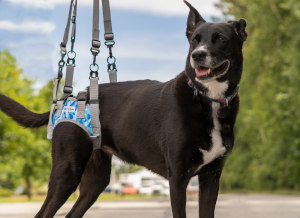
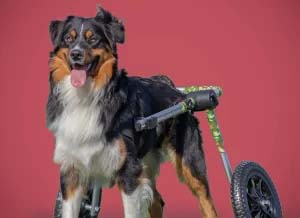

There are many ways a dog can become paralyzed. Many dog breeds have a genetic predisposition to illnesses that cause paralysis, such as Intervertebral Disk Disease (IVDD) or Degenerative Myopathy (DM), traumatic injuries such as falls or abuse can cause the loss of mobility, as well as old age illnesses such as arthritis.
Paralysis doesn’t only occur in older dogs. It’s even possible for a dog to be born paralyzed. Paralysis can occur in one, two, or all legs. Dogs showing signs of paralysis, such as: dragging limbs, weakness, pain, or inability to walk properly, need to be treated by their veterinarian immediately. Depending on the cause, immediate treatment may mean a better recovery.
Paralysis and leg weakness can affect both your dog’s front and rear legs. The cause of the paralysis can vary greatly depending on the limb it affects.
Commonly caused by damage to nerves in the neck or shoulder, or the radial, median, or ulnar nerves in the leg.
Most often, sudden paralysis impacts a dog’s hindquarters. Hind leg paralysis is most commonly caused by nerve damage in the tailbone or lower back or in the tibial, femoral peroneal, or sciatic nerve in the rear leg
Inability to move any limb. Tetraplegia is full paralysis in all four legs at the same time.
Paresis occurs when a dog is only partially paralyzed. They are able to move, but can not move easily.
Although, most often a dog’s legs are paralyzed paralysis can also occur in other parts of the body, including the facial muscles.
Seek immediate medical attention If your pet is experiencing any of the above symptoms.
There are many conditions that can cause a dog to become paralyzed, here are some of the most common canine mobility conditions:
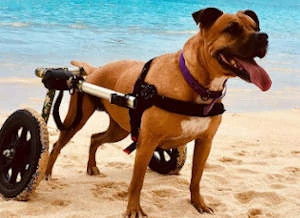
Paralysis in dogs is usually caused by a problem in the spine or brain. Spinal compression, herniated discs, and nerve problems can all disrupt the communication between a dog’s spine and brain. When the nerves are unable to function normally, dogs will lose the ability to walk, stand, and control their legs.
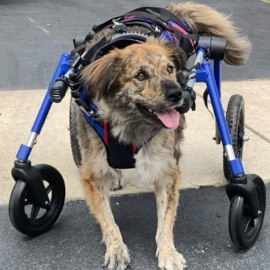
In many canine paralysis cases, a dog can recover the use of its back legs, but there are a lot of factors that go into determining this. How long it takes for a dog to recover from hind leg paralysis will vary. Some paralyzed dogs will recover very quickly and only be hospitalized for a short period.
However, a dog that is left paralyzed and has significant nerve damage will be a much slower recovery process. Nerves regenerate slowly and heal about 1 inch every month. Regaining full use of their back legs is possible, but the severity of the injury, whether it impacted the spines, nerves, or muscles, how quickly the dog receives treatment, and the location of the injury or spinal damage.
While some nerve damage can resolve over many weeks or months. Giving your dog massages, applying heat, and stretching the tendons will help keep them healthy while the nerve regenerates. Acupuncture, laser therapy, and hydrotherapy have also been shown to be helpful in rehabbing paralyzed limbs and may be prescribed, as well as anti-inflammatory medications and steroids to reduce inflamed nerves.
What do you do when your dog is unable to walk? How you help your dog to walk again will vary depending on your dog’s symptoms and their sudden paralysis treatment will vary depending on the cause. It is important to follow Veterinary guidelines to care for your pet and monitor their condition.
Not all paralysis is a permanent condition. Many joint and muscle issues can be helped with surgery and physical therapy. If your paralyzed dog has had a nerve-related injury, the recovery will depend on the nerve sheath condition and how far the injury is from where the nerve ends.
Depending on the severity and cause, surgery may slow down the effects or even correct your pet’s paralysis. Tumor removal, amputations and spinal surgery to correct nerve damage are just a few possible surgical solutions. Immediate medical care and early diagnosis can be key to getting your dog back on its feet as quickly as possible.
Following post-operative guidelines are iatrical for a successful recovery. Speak with your Veterinarian and make sure that your know what steps you need to follow after your dog’s surgery.
In cases of bacterial or fungal infections, the symptoms can be treated with drugs and antibiotics. If your dog is experiencing any pain, the Vet may prescribe pain medications as well. Create a medication schedule to ensure you don’t miss a single dose.
A recent study showed that certain drug therapies are effective in treating dogs paralyzed by IVDD or certain traumas. During this study, dogs involved in the medical trial showed improvement after their course of treatment was completed.

Your Veterinary Surgeon may prescribe acupuncture, stretching, massages, or working with a Canine Rehab Therapist as part of your dog’s recovery plan. The types of rehab therapy needed and the frequency will vary depending on the underlying cause of your dog’s mobility loss.
There are many different types of therapy including massage, acupuncture, stretching, laser therapy, structured exercise, and hydrotherapy.
In many canine paralysis cases, most of the care will be done at home. Your Veterinarian will help you to make a plan to properly care for your dog. Restricting your dog’s mobility through creating rest is common, especially in cases of spinal disease.
Follow your Veterinarian’s plan closely until your dog is fully recovered. Administer the full course of prescribed medications even if your dog appears to be fully recovered. If you have any questions, always call your Vet.
A paralyzed pet will have additional needs, luckily with a little assistance, they can go on to live a relatively normal life. Most importantly, your dog needs to be able to get exercise.
The first thing to pick up for your paralyzed dog would be a wheelchair! The rear wheelchair can help get your best friend up and mobile. They will be able to go out to the bathroom, go on walks, and play! The wheelchair can also prevent further injury, such as pressure sores and rubbing from dragging their weight.
Depending on if your dog is continent or not, doggie diapers may be helpful to keep your house free from urine and feces.
Finally, a lifting harness would be a great start to helping your paralyzed dog. A rear harness will help you get your dog up the stairs, into the car, outside for your dog to go to the bathroom, and around on short walks!
The key to caring for a paralyzed dog is ensuring you have all the right tools available. Paralyzed dogs require special care and support to heal and stay active. Whether the paralysis is temporary or permanent, many assistive devices are available to help make your life easier and get your dog moving again.

A supportive harness for dogs with hind leg weakness. Allowing you to gently lift and support your pet.
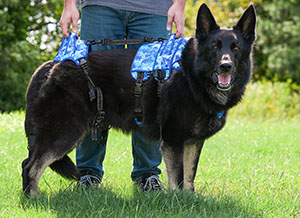
A perfect lifting harness for pet’s needing support in both the front and rear legs. This is a great option for supporting pets with DM and other progressive conditions.
This harness is also ideal for assisting pets on stairs.
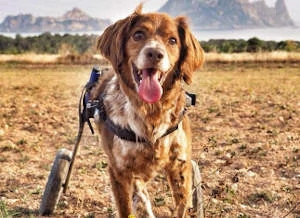
A dog wheelchair gives your dog independence, allowing them regain their mobility and get around freely. A great addition to your dog’s rehabilitation and recovery. Getting a dog back on their feet quickly can help promote healing.
Dogs that are fully paralyzed need to be fitted with a wheelchair. Some dogs with a condition like degenerative myelopathy may do best with a wheelchair. One of my German Shepard patients has degenerative myelopathy. He can rise from the ground on his own and walk a little bit unassisted, but he often drags his feet and will tire easily. He loves his wheelchair! My patient loves to run in a wheelchair on paved paths in the neighborhood. His owner still encourages him to use his back legs most of the time to help him work on his muscle strength and practice walking. However, time in the wheelchair allows him to feel free to experience the joy of movement that is easy and carefree.
Dr. Nicole Cohen, DVM., DABVP.
While that is only a question you and your veterinarian can answer, there have been so many advancements in the way veterinary professionals are thinking about paralysis and the dog’s quality of life. The good news is that paralysis does not have to be an end-of-life decision. If your dog is happy and showing no signs of pain, there is no reason to euthanize your pup, and with just a little extra help from you, they are able to live normal, active lives!
Dog wheelchairs are an incredible tool that helps paralyzed pets regain their mobility and live normal, active lives. Dog mobility carts improve the quality of life for paralyzed and handicapped dogs around the world. Since 2001, Walkin’ Pets has helped change the lives and mobility of over 1.85 million dogs!



Subscribe to our Email Newsletter
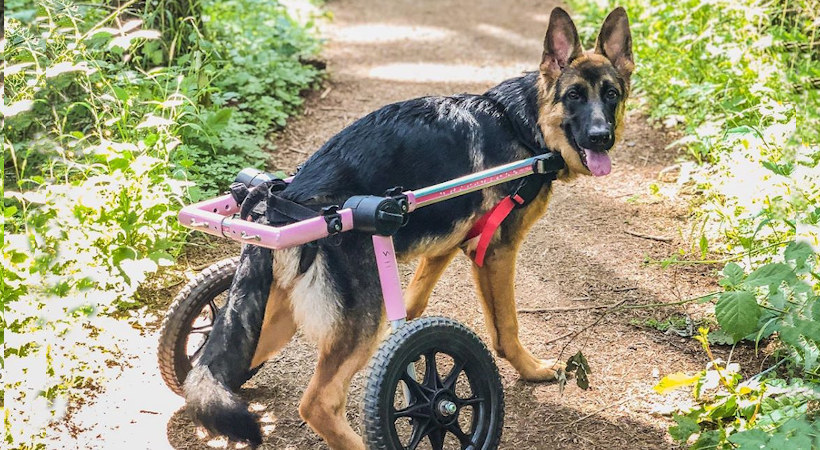

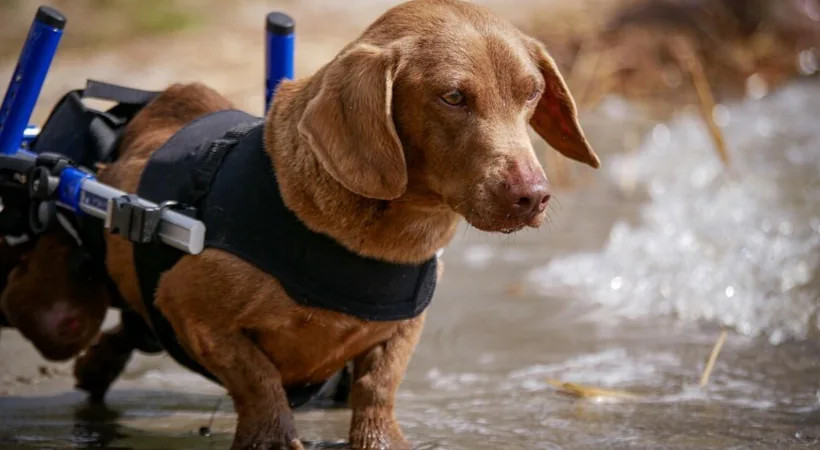
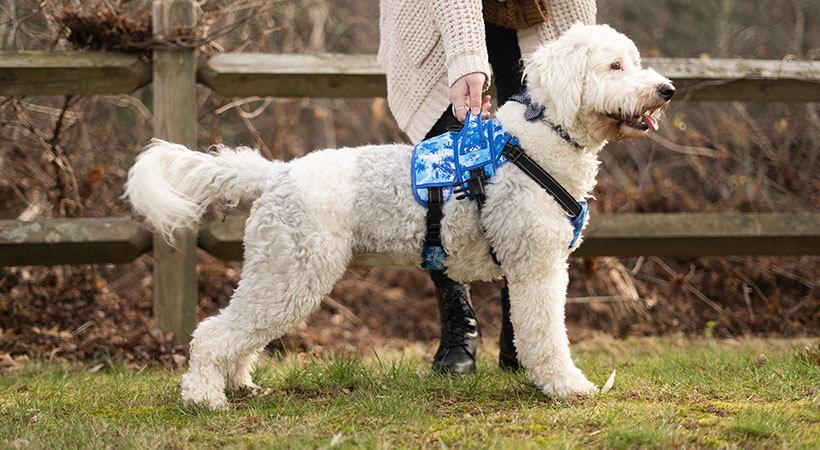


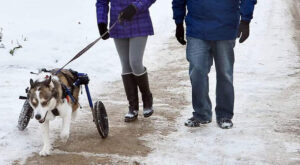


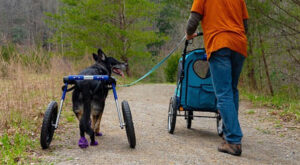





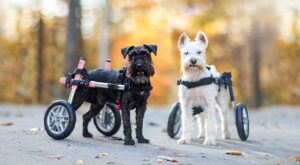
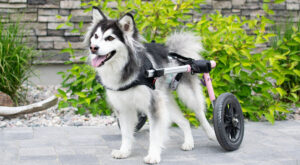
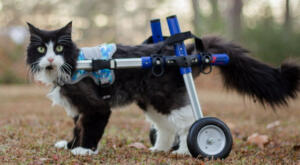

Hello,
My 3 year old Japanes spitz suddenly can not walk – suddenly the hind legs have given up. She cannot stand on her own. How can i help her so as to be mobile and be able to pee/poop at least? Her appetite is also down. Took her for an xray – nothing in the spine, nor vertebrae.
I am really scared as i have had her from birth….
Please advise me what to do…
Regards from Kenya
Hi Shemina, I’m so sorry to hear about your pup. It sounds like your dog might benefit from the support of a wheelchair. The Walkin’ Wheels wheelchair will support her hind end from underneath, allowing her to stand, walk, and pee or poop on her own. Please contact us at 888-253-0777, we would be happy to help answer your questions!
Why my dog suddenly can’t walk and then after sometime his is normal. why this is happening? Its been 5 times.
I have had the same problem with my Doberman. I suddenly notice he is standing leges braced for a minute or two, then looks confused about what happened and is fine. It has happened 5 times over 3 years with no apparent cause. Otherwise he is very active, runs fast and jump in and out of my suv with ease.
Hi Eowyn, If you need a shoulder strap I would recommend using the Lift-N-Step Harness, this harness will support your dog’s entire body and allow him to go to the bathroom freely. If you have any questions, please call us at 888-253-0777
I have a 8 or 9 year old chihuahua that has recently lost the ability to use his back 2 legs. I want to take him to the vet but, I DO NOT HAVE ANY MONEY in order to take him in though. I really NEED HELP HERE IF SOMEONE CAN OFFER ANYTHING IT WOULD BE MUCH APPRECIATED! I LIVE IN LEVITTOWN, PA BY THE WAY!! I NEED HELP FAST I AM NOT JOKING HERE I’M DEAD SERIOUS PHONE – 856-883-5998
Jason, I am so sorry to hear about your Chihuahua, there are resources available to help pets in need. Please find a list of organizations that are able to offer your support here: https://www.www.walkinpets.com/financial-aid-for-pets/ If you have any questions, please call us at 888-253-0777
Hi Jason
Im sorry your pupper isn’t doing well. Although i have never tried to get funds through a grant I do know there are grants available. First try calling a local animal shelter, ask the question are there any Chihuahua rescues locally…even if it’s far get name call ask them if they know of available organizations that can help. Check some rescues on Petfinder ask them. Even try calling a veterinarian.college, sometimes they are very reasonable and a good lesson for students to see. There’s also Waggle.com i think it’s like GoFundMe for pets. I know some grants are breed specific, keep asking until you find what you need. Some of the local pet stores are aware of rescues keep reaching out. Nothing but love tail wags and milk bone kisses from long island’s Pittie-ful 4 pack and human treat dispenser. Best of luck.
I have a jack russell who just turned 10, 2 days ago he woke up and can no long walk his back legs are frozen in place what can I do? I don’t know what to do .
Paralysis of Front legs – my shitzhu beagle cross has suddenly lost control of her front legs. Vet has treated her for snake bite but no improvement. Are there any aids that can help her get around.
For front legs there are a few different ways you can provide support. A front lifting harness can be used as well as a full support dog wheelchair to help keep her active. Please call us at 888-253-0777 and we can discuss all the support options available.
Okay some of theses comments are in 2023. My French bulldog is 2 yrs old and he was a pretty healthy dog, then out of nowhere both of his back legs just stopped working. He eats but not voluntarily, he also needs help peeing and pooping.We took him to the vet and they gave us some medication. But if it doesn’t kick in in 6 days we have to put him down. Its hard to even look at him without tearing up because this has never happened. Please tell us how to help him.
Hi Tyliah, I’m so sorry to hear about your French Bulldog. Have you spoken to a canine rehab specialist or veterinary neurologist? Spinal issues are common in French Bulldogs and many treatment methods are available depending on the diagnosis. Euthanasia is not the only option, I recommend getting a second opinion and determine what’s causing your Frenchie’s paralysis. With proper treatment and support, there’s no reason why you’re dog can’t live a long, active life.
My 11 year old Siberian husky started acting strange 4 days ago first starting with her back legs not being able to stand or put pressure on and the next afternoon all 4 legs. We rushed her to the vet and they said it maybe tick related so they gave her medication and fluids and 36 hours later no results they consulted a specialist and the other 2 options is not possible because she has had no contact with dead animals or been bit by a raccoon. None of my other 2 big dogs or 4 puppies have any symptoms. Her blood work up and physical work up shows she is completely healthy so the vet and me are stumped. No one has a clue what the problem could be. She will snatch her foot away if you push her paws but she cannot hold her head up or move other than that. Any ideas. We don’t want to put her down by no means but if the vet cannot figure it out what other option do we have she has always been a very active dog and is miserable but she is not in pain. Any help would be appreciated.
Hi Rhonda, So sorry to hear about your husky. It sounds like you’re taking all the right steps to make sure she’s getting the care she needs. If you haven’t yet, I would ask your veterinarian if they would recommend her being seen by a specialist. A veterinary neurologist may be able to give you a better sense of what’s going on. From what you’re describing, it does not sound like euthanasia is the only option. Many paralyzed pets can live a long and active life in a wheelchair. Please give us a call at 888-253-0777, we’d be happy to answer any questions you may have.
Hi Rhonda, I have the same problem with my dog too. I have a female chihuahua 8-9years old, I saw her 1 time(Sunday) she loses balance on her back legs I thought she slipped since our flooring is tiles, I ignored it. On the 2nd day Monday morning, she is like very tired able to walk but slowly, until on the afternoon she cannot walk but able to sit, then Tuesday he cannot stand anymore, she is able to move his body but legs aren’t(I knew her legs are all paralyzed that time). She eats the same as before its like nothing happened to her.
I took her to the vet and didn’t find any strange they gave me meds and vitamins for my dog.
On Thursday the only part she can move is her head until neck, but from neck down it was all paralyzed(Tried to pinch her a little which is she hated most, she doesn’t react to any part of her body.) and she eats lesser and lesser and lesser until today Saturday. I just wanna know what happened to your dog? Does she able to walk again? Any Tips? If you read this or anyone reading this that has the same problem like my dog, please do email me at charm.esguerra.of@gmail.com
I have a dog that suddenly lost the use of her back legs. Took her to the vet and x-rays and blood work didn’t show anything. She is alert and eats and drinks good. Help
Hi Robyne, I’m so sorry to hear about your dog. We know how difficult it is to see your dog struggling with no answers. I would recommend reaching out to a specialized veterinarian, possibly a neurologist, who might be able to help diagnose your dog. We’re always here to help, so please feel free to give us a call at 888-253-0777.
I’m in a right stew, for want of a better word. About 4 weeks ago our Frenchy’s back legs became paralyzed for no reason what so ever. No prior symptoms nothing. I took her to the vets and asked him to put down being as she wasn’t eating and drinking also. He didn’t know what was wrong with her. Just gave her some medicine.
In Thailand vets do no like to euthanise animals. I won’t go into the ways of Thais and their beliefs.
Anyway I’m now stuck with a dog that’s incontinent and a burden. Other than euthanise her myself, which I don’t want to do, I’m stuck. The dog has no life even though we bought her a dog wheelchair. She doesn’t respond when we put her in it and she just lays in her basket. I really hate Thai vets.
Hi Michael, I’m so sorry to hear about your dog. There are several animal rescues in Thailand that specialize in the care of special needs dogs, including The Man That Rescues Dogs and The Elephant Nature Park. I would recommend reaching out to them for advice and support.